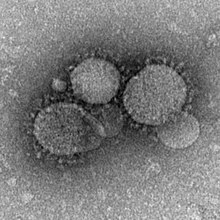Hello, dear readers.
Here we go again, as Whitesnake said, with another entry of the blog. This time, we are going to speak about the ever-present, ever-menacing, flu. As this will be the first entry, it will be about the basics: What is the flu? and Why is it so dangerous?.
Also, with this second entry, we expect to surpass the hundred visits. It is not much, but it will be something to look back at and marvel about, in the future.
So, here we go. With all of you, The Influenza virus.
 |
| Everyone, say hello to the Flu Virus |
First, What is the Influenza Virus? We are in front of one virus from the family Orthomyxoviridae, with a genetic material composed of 8 fragments of single-stranded, positive, RNA, which makes it very prone to recombinations.
It is a virus with a glycoprotein membrane, with two key proteins for the cell entry, called Hemaglutinin (HA) and Neuroaminidase (NA). This proteins have many variations, employed to define the virus using the HxNx format, where x is a number
What not many people knows, is that there are 3 types of influenza virus, A, B and C. Here I leave you a link to a nice sum up from the CDC. Seasonal flu, which is know (and suffered) by mostly everyone, normally is type A or B. In the case of it being type A, it will be accompanied by the suffix HxNx. This is a distinct nomenclature (a way of call something) that is determined by the subtypes of HA and NA. I am not going to write about the HA that binds to sialic acid nor the process used by the NA to break that acid so the virus enters the cell.
What I am going to say is that there are 18 types of HA and 9 types of NA, that combine freely to form different viruses. Luckily for us, not all of them infect humans, many of them only infect animals, such as birds, horses and bats.
But, Why is the flu virus so dangerous? As I mentioned earlier, there are 8 segments of ssRNA composing the genome of the virus, causing different combinations of HA and NA, among other things. If a human got infected by a swine flu, the effect will be contained, because it will not be transmitted human to human, only pig to human. The mortality rate will be asthonishingly high (about 40%), but the effect will be controlled and focused. To give you a brief idea, this is a link to the WHO about the evolution of H7N9, a kind of flu that is starting to infect humans.
The problem comes when said pig-to-human flu happens to infect a human that already has been infected, in that same moment, with a human-to human flu. There is a process, which I am not going to explain today, but in next monday's entry, by which both genomes can recombine their segments causing a new flu virus to be formed. And this virus, in this unlucky guy, would have the mortality rate of the first, and the infective power of the second. It will be highly mortal and easily spreadable. So, if you know someone who is really unlucky, and he has the flu, better step away for a couple of weeks. Just in case...
 |
| This happened the last time Flu became dangerous |
This may sound as a fantasy or an excuse to sell vaccines by the pharmaceutical companies, but it has happened before. in 1918, the Spanish Flu killed between 3% and 5% of the world population, affecting mostly young, healthy adults. In today's numbers, it would have killed around 350 million people.
That is a lot, don't you think?
This happened in 1918, in the middle of World War I, and it has the name of Spanish Flu because Spain did not intervened in said war, thus freely reporting the devastating disease. The thing is, it originated in France, and started to spread from Boston to New York. But no one reported it, so the morale of the troops would remain intact. And the nickname stayed, granting fame (but not fortune) to all spaniards in the viral world.
The funny thing with the flu is that. Normally, is a minor disease, that keeps you in bed for a couple of weeks, and exhausted for nearly a week. But you recover and keep going on. It is a controlled illness, higly infective, but almost no one dies from it nowadays.
A couple of years back, there was a scare about the "avian flu". It had all the qualities to become another Spanish Flu. It had jumped from birds to humans, and had the first cases of human-to-human infections. But suddenly it stopped working, and left us with our bones rattled about a case of lethal, global, devastating pandemic disease. Nothing important, really.
Here, also, is a cool new 3D model that came out some days ago
Here, also, is a cool new 3D model that came out some days ago
 |
| Official flu reports in the past 6 months |
That is why we like the most about viruses. They are these little things, that no one really cares about. But if they have one bad day, and start killing people, odds are in favor of a massive global decimation.
So, we will keep the entrys coming, hopefully each Monday, as long as viruses let us do our work.
Thanks for reading!

